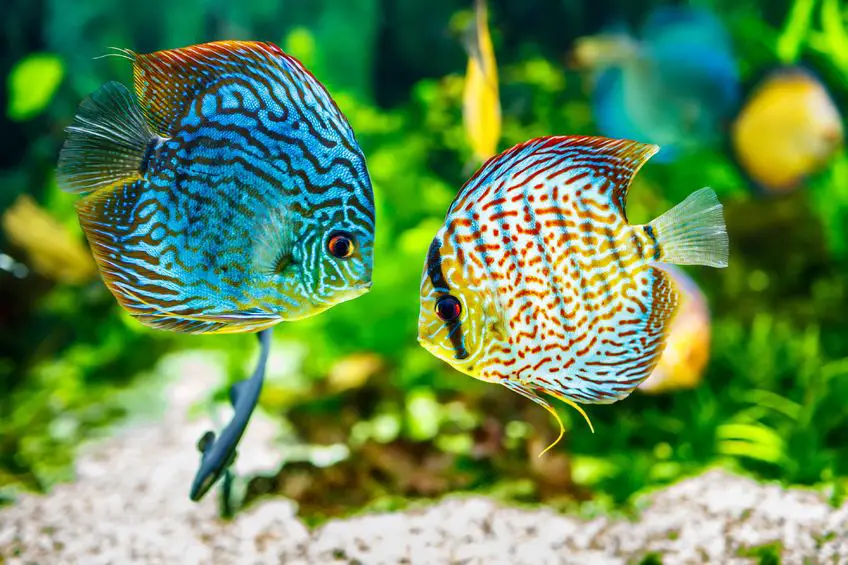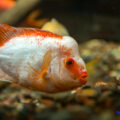Last Updated on May 10, 2023 by QCity Editorial Stuff
Fish cannot see water in the same way that humans cannot see air. To a fish, water is simply a part of their surroundings, and they are unlikely to be consciously aware of it as a separate entity.
Anatomy of Fish Eyes
Fish have an interesting anatomical feature in the form of their eyes. The language links on the top of the Wikipedia page for fish tell us that they are similar to the eyes of birds and mammals, but they have a more convex lens. Their retinas generally have both rod and cone cells, and most species possess tapetum lucidum that gives them better vision in low light. Fish have a gradient within the lens that compensates for nearsightedness, and they adjust focus by moving the lens closer or further from the retina. Unlike humans, fish cannot adjust to light levels by contracting and dilating the pupil. Instead, they undergo a synchronized shift of the rod and cone cells and dark pigment granules to adapt to different light levels. Overall, fish eyes are well-suited to their aquatic environment and unique light conditions.
Fish Vision in Water

Fish are known for their amazing vision in water. Here are some interesting facts about how they see things underwater.
- Fish cannot see the water around them, just like humans cannot see the air around them.
- This is because the brain of all fish, and other creatures such as amphibians, reptiles, birds, and mammals, is adapted to ignore insignificant environmental stimuli in order to function efficiently.
- Fish have all the basic senses, including vision, and their eye structure is very similar to that of humans. They have a cornea, lens, iris, pupil, and retina.
- Without eyelids, fish do not need protection for their eyes as they are constantly getting washed by water.
- Fish possess photoreceptors that quickly convert stimuli into electrical signals and send them to the brain through the optic nerve.
- Fish have a wider field of vision than humans due to the spherical shape of their lenses.
- However, this comes at a cost as fish cannot focus on distant objects, resulting in blurred vision.
- Fish are better adapted to detecting movement and contrast rather than details.
- Fish can see colors because they have cones in their eyes, just like humans. The number of cones can vary among different species.
- Predatory fish have an advantage over their prey as their eyes can adapt more quickly to changing light levels.
- Light behaves differently in water, and it takes fish some time to adjust to changes in light levels.
Perception of Colors by Fish
Fish perceive colors differently than humans due to the characteristics of light in water. Attenuation, caused by scattering and absorption, limits the intensity and changes the color of the light as it moves through the water. Longer, red wavelengths are absorbed more quickly and penetrate shallower depths than shorter, blue, and violet wavelengths. This means that a red fly at 10 feet depth appears gray to a fish. However, many fish species can see colors beyond the human range, including ultraviolet. UV vision is particularly useful for identifying potential mates and recognizing predators. Color plays a crucial role in the lives of many fish species from camouflage and communication to mate selection and species recognition.
Vision in Different Water Environments
Fish have adapted to various water environments, and their vision plays a crucial role in their survival. Here are some facts about fish vision in different water environments.
- In Clear Water:
Fish can see colors up to a depth of 75 feet and can detect subtle variations in color. They also have a better contrast sensitivity than humans, which helps them distinguish between objects in clear water.
- In Muddy Water:
Fish have a harder time seeing in muddy water due to reduced light penetration. However, they have adapted to this environment by developing senses such as their lateral line, which detects vibrations, and their sense of smell, which helps them locate prey.
- In Deep Water:
Fish have adapted to deep water environments by developing larger eyes to absorb more light. They also have specialized photoreceptor cells that allow them to see in low-light conditions and detect bioluminescence from other creatures.
- In Turbid Water:
Fish have mastered the art of detecting movement in turbid water, as it helps them locate prey. They also have photoreceptors that respond to ultraviolet light, which is abundant in turbid water.
Fish Detection and Camouflage
Have you ever been fascinated by how fish can seemingly disappear from predators in the open waters of oceans? Scientists have discovered that fish use microscopic structures called platelets in their skin cells to reflect polarized light, making them invisible to predators. This discovery could help materials scientists and military technologists in creating more effective methods of ocean camouflage. Fish have evolved the means to detect polarized light and hide in it, making them harder to detect in the open ocean. Of the three ways light patterns help in detecting targets in the water, polarization contrast is considered the most effective. The U.S. Navy has supported research exploring how fish avoid detection in the open ocean as they seek to master this kind of camouflage.
Fish Vision and Prey Detection

Fish have unique eyes that are adapted to the underwater environment. Their spherical shape allows them to see in all directions, while their thick lenses help correct light refraction and perceive more light. However, fish cannot see the water itself because their eyes are designed to focus on objects within the water. The clarity of the water only affects how far a fish can see. Fish use a combination of body movements and eye rotations to track their prey and navigate their environment. Their photoreceptors send signals to the brain via the optic nerve, enabling them to quickly detect and react to potential predators or prey. While many fish have excellent color vision, some species can only perceive certain colors or only see in low-light conditions. Overall, understanding a fish’s vision and prey detection can help improve our own fishing techniques.
Evolution of Fish Vision
Fish have been around for 450 million years, and during this time, nature has tried many different approaches to develop their sight underwater. Some species like the hagfish have little more than light-sensitive cells, while many possess highly developed vision. Fish have some of the best visions in the animal kingdom, surpassing that of humans. A fish’s eye is quite similar to a human’s, but the components work slightly differently due to light behavior underwater.
Fish have a rounded cornea, allowing them to receive light information from a wide field of view up to 360°. Their lenses are almost spherical, focusing on objects only in the center of their view. Fish eyesight is better suited to see movement and contrast rather than actual detail. They adjust the focus by moving the lens closer to or further from the retina. Fish retinas have both rods and cones. Some can see in colors, while others are sensitive to ultraviolet light. Fish vision evolves to suit their visual environment, with eyes better adapted to their surroundings.
Conclusion
In conclusion, while fish cannot see the water that surrounds them, their eyes have evolved to see more colors and light than humans. Fish have a high refractive index, allowing them to catch and perceive more light, which gives them an advantage in viewing their environment without distortion. Their round eyes, with thick lenses, make them excellent at seeing things around them and getting a broad panoramic view.
References:






